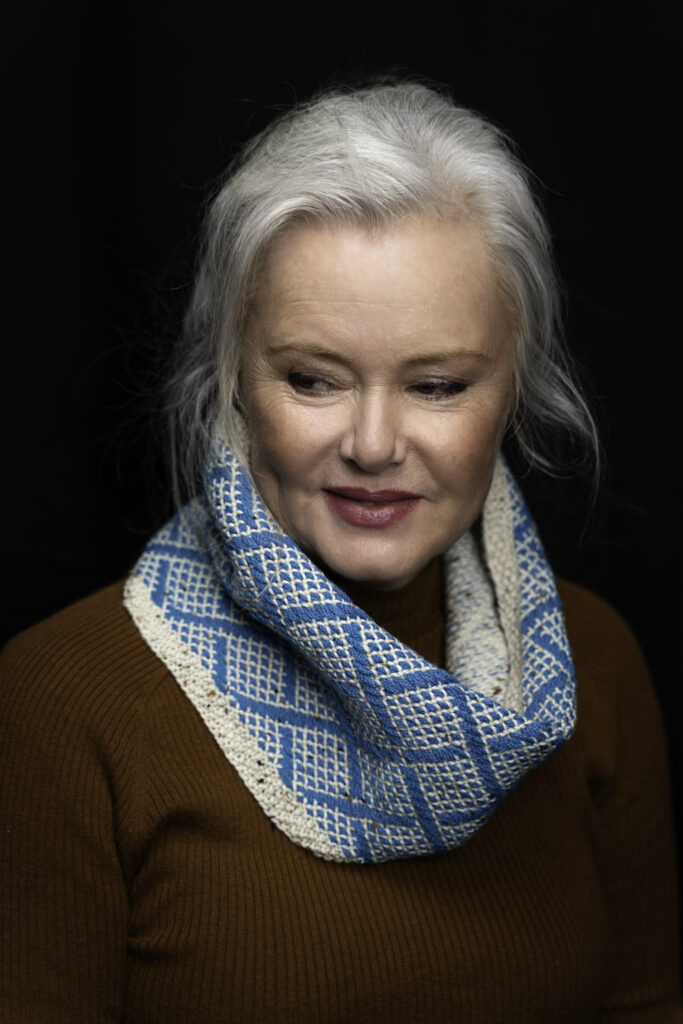Knitting Patterns, Advanced Beginner, Scarfs Cowls
Woven Illusion Cowl Knitting Pattern
Just released today! My Woven Illusion Cowl knitting pattern. This is the first in a series of circular cowls exploring a vintage technique. The illusion is that looks like it has been woven. In reality, it is created on your knitting needles.
Buy in my store or Buy in RavelryWhere did the inspiration come from for the Woven Illusion Cowl?
I saw a video of a Spanish or Portuguese Designer talking about this woven looking technique. She said she saw it on a vintage pattern and decided to try it out. She was offering a weekend workshop on how to do the technique. I wasn’t available at the time of the workshop so, decided to work it out myself. I have no idea if her version of the technique is the same as mine or different. Either way, two designers releasing patterns in the same technique draws twice as much attention to it which is great.
What yarn is used in the pattern?
My challenge for myself was to make as many of the knitting designs in this series as I could from my stash. The technique doesn’t use much yarn so, it’s perfect when you have a spare ball or two.

This first Woven Illusion design used DK weight yarn. I had a wonderful Teal colour from Bendigo Woollen Mills I had originally bought for my Egypt Shawl. It’s gorgeous but I found the shade to be a bit too dark for what I needed. It is Classic 8ply which is a Crepe structure making for a crisp stitch which has volume and bounce.
Bendigo Woollen Mills Classic 8 ply https://www.bendigowoollenmills.com.au/classic-8-ply

The cream grid colour was a low cost blend from Spotlight stores called “4 Seasons Montrose DK” colour Porcelain. It was a mix of wool, alpaca plus a tiny percentage of acrylic and viscose. The blend makes for a yarn that is lightweight and super soft. It may not last as well as the 100% wool from Bendigo. However, as a cowl, it won’t have a lot of heavy wear and tear anyway. I really love the nepps in this colour. Too many yarn companies try to get creative by adding nepps full of weird and wonderful colours. They drive me nuts when I want to avoid clashing colours. The Montrose nepps are subtle in natural shades.
Although I would prefer to use two yarns that are of similar construction, this was what the stash had on offer. I think the softness of this Montrose blend was also a good offset for the Bendigo yarn that might not be so gentle on the neck.
Spotlight Stores 4 Seasons Montrose https://www.spotlightstores.com/art-craft/yarn-needle-art/yarn/wool-blends/4-seasons-montrose-8-ply-yarn/BP80629569-porcelain
Learning the Woven Floats Technique
Working from very little reference material meant I was playing with this technique for few days. Learning the basics was one thing, but then, I spent quite a bit of time studying the behaviour of the stitches. I wanted to study how to enter and exit a float which creates the bold lines in this pattern. Also, when do floats like to sit together and when do they repel each other like duplicate ends of two magnets. For basics, take a look at the article on Woven Floats Technique.
Buy in my store or Buy in RavelryMaking the Woven Illusion Cowl Prototype

Starting off with a simple woven inspired stitch pattern was a great way to start. The chart is not big which means it’s easy to follow. You can add and take away the number of charts to alter the width and depth of the finished Illusion cowl. I used moss stitch on the border as it was a similar gauge to the woven section.
Learning from Mistakes
There were mistakes… which is always useful as part of the learning. I found I could dig down a column to correct the grid yarn if I had sent it in the wrong direction. It’s not a simple at digging down a stocking stitch column – more like digging down inside a cable column.
Sometimes I wouldn’t know how to get back up to the working row so I would continue to fiddle, trying different sts until the result matched the original chart again. When I had no friggin’ idea how to get back to the working row, I would put a stitch marker through the last stitch in the column that was successfully zipped up again and then would unravel the work back to that stitch.
Luckily that only happened once. I learnt it is useful to look back along the chart row you’ve just completed to check the grid and floats look correct.
The tension between stitches is also very important. Just like colour work where you make the floating colour slack, it is helpful to have your contrast colour at least “relaxed” whilst working. If you knit tight, you may have to go back over the last sts you’ve just completed and literally drag them apart to allow more space for the contrast colour to “breathe”.
All in all, it was a fun project that didn’t take a lot of time. The finished result drapes surprisingly well, is very snuggly and produces a truly stunning, crisp pattern.
SUBSCRIBE to hear about each cowl in the series as they are released.
Buy the pattern here
 Here’s a final little shot when the photographer’s puppy jumped up into my lap on the high stool. He is such a bundle of joy. I doubt he is told off very often. He’s just too lovable.
Here’s a final little shot when the photographer’s puppy jumped up into my lap on the high stool. He is such a bundle of joy. I doubt he is told off very often. He’s just too lovable.
Buy in my store or Buy in Ravelry


Pingback: Peru Double Cowl Knitting Pattern - DrummRoll Knitwear, Annabelle Drumm